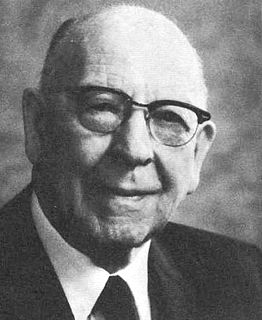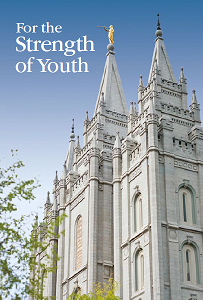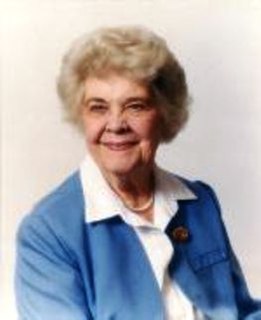A stake is an administrative unit composed of multiple congregations in certain denominations of the Latter Day Saint movement. The name "stake" derives from the Book of Isaiah: "enlarge the place of thy tent; stretch forth the curtains of thine habitation; spare not, lengthen thy cords, and strengthen thy stakes". A stake is sometimes referred to as a stake of Zion.

Harold Bingham Lee was an American religious leader and educator who served as the 11th president of The Church of Jesus Christ of Latter-day Saints from July 1972 until his death in December 1973.
The status of women in Mormonism has been a source of public debate since before the death of Joseph Smith in 1844. Various denominations within the Latter Day Saint movement have taken different paths on the subject of women and their role in the church and in society. Views range from the full equal status and ordination of women to the priesthood, as practiced by the Community of Christ, to a patriarchal system practiced by The Church of Jesus Christ of Latter-day Saints, to the ultra-patriarchal plural marriage system practiced by the Fundamentalist Church of Jesus Christ of Latter-Day Saints and other Mormon fundamentalist groups.

Sacrament meeting is the weekly worship service held on Sunday in The Church of Jesus Christ of Latter-day Saints.

LeGrand Richards was a prominent missionary and leader in The Church of Jesus Christ of Latter-day Saints. He served as the seventh presiding bishop of the LDS Church from 1938 to 1952, and was then called as a member of the Quorum of the Twelve Apostles by church president David O. McKay. Richards served in the Quorum of the Twelve until his death in Salt Lake City, Utah, at the age of 96.
The law of chastity is a moral code defined by The Church of Jesus Christ of Latter-day Saints. According to the church, chastity means that "sexual relations are proper only between a man and a woman who are legally and lawfully wedded as husband and wife." Therefore, abstinence from sexual relations before marriage, and complete fidelity to one's spouse during marriage, are required. As part of the law of chastity, the church teaches its members to abstain from adultery and fornication.
In The Church of Jesus Christ of Latter-day Saints, a church membership council is an ecclesiastical event during which a church member's status is considered, typically for alleged violations of church standards. If a church member is found to have committed an offense by a membership council, he or she may have their name removed from church records, or their church membership may be otherwise restricted. Church membership councils are at times referred to unofficially as church courts.

"For the Strength of Youth" is a pamphlet distributed by The Church of Jesus Christ of Latter-day Saints that "summarizes standards from scripture and from the writings and teachings of Church leaders." The pamphlet's target audience is young men and young women of the LDS Church, although its principles are applicable to all age groups in the church. It is available on the Internet and in print form. The pamphlet was first published in 1965, and its 9th and most recent edition was released in 2011. The pamphlet was meant to be put "in the hands of every young person in each ward".

The basic beliefs and traditions of The Church of Jesus Christ of Latter-day Saints have a cultural impact that distinguishes church members, practices and activities. The culture is geographically concentrated in the Mormon Corridor in the United States, and is present to a lesser extent in many places of the world where Latter-day Saints live.
Worship services of The Church of Jesus Christ of Latter-day Saints include weekly services, held in meetinghouses on Sundays, in geographically based religious units. Once per month, this weekly service is a fast and testimony meeting. Twice each year, the LDS Church holds a worldwide general conference. LDS Church adherents also worship in temples, which are open only to members in good standing.
Sexuality has a prominent role within the theology of The Church of Jesus Christ of Latter-day Saints, which teaches that gender is defined in the premortal existence, and that part of the purpose of mortal life is for men and women to be sealed together, forming bonds that allow them to progress eternally together in the afterlife. It also teaches that sexual relations within the framework of opposite-sex marriage is healthy, necessary, and ordained of God. In contrast with some orthodox Christian movements, sexuality in the Church's theology is neither a product of original sin nor a "necessary evil".
In Mormonism, revelation is communication from God to man. Latter Day Saints teach that the Latter Day Saint movement began with a revelation from God, which began a process of restoring the gospel of Jesus Christ to the earth. Latter Day Saints also teach that revelation is the foundation of the church established by Jesus Christ and that it remains an essential element of his true church today. Continuous revelation provides individual Latter Day Saints with a "testimony", described by Richard Bushman as "one of the most potent words in the Mormon lexicon".
The Young Women is a youth organization of The Church of Jesus Christ of Latter-day Saints. The purpose of the Young Women organization is to help each young woman "be worthy to make and keep sacred covenants and receive the ordinances of the temple."
The Young Men is a youth organization and official program of The Church of Jesus Christ of Latter-day Saints. Its purpose is to assist the church's Aaronic priesthood-aged young men in their growth and development. The organization serves young men from the year they turn 12 until they are 18.
An organization is a secondary body of church government within The Church of Jesus Christ of Latter-day Saints that is "established for moral, educational, and benevolent purposes." Prior to October 2019, the church's organizations were called auxiliary organizations. As the term suggested, the LDS Church's organizations are ancillary to the governing power of the priesthood in the church. The LDS Church's five organizations are Primary, Relief Society, Sunday School, Young Men, and Young Women.
Mary Ellen Wood Smoot was the thirteenth Relief Society General President of The Church of Jesus Christ of Latter-day Saints from 1997 to 2002.

Ruth Hardy Funk was the seventh general president of the Young Women organization of The Church of Jesus Christ of Latter-day Saints from 1972 to 1978.
Various councils meet on a local stake and ward level within The Church of Jesus Christ of Latter-day Saints. These include:

The Church of Jesus Christ of Latter-day Saints focuses its doctrine and teaching on Jesus Christ; that he was the Son of God, born of Mary, lived a perfect life, performed miracles, bled from every pore in the Garden of Gethsemane, died on the cross, rose on the third day, appeared again to his disciples, and now resides, authoritatively, on the right hand side of God. In brief, some beliefs are in common with Catholics, Orthodox and Protestant traditions. However, teachings of the LDS Church differ significantly in other ways and encompass a broad set of doctrines, so that the above-mentioned denominations usually place the LDS Church outside the bounds of orthodox Christian teaching as summarized in the Nicene Creed.
On many occasions spanning over a century, leaders of The Church of Jesus Christ of Latter-day Saints have taught that adherents should not masturbate as part of obedience to the code of conduct known as the law of chastity. The LDS Church places great emphasis on the law of chastity. Commitment to live the law of chastity is required for baptism, and adherence is required to receive a temple recommend, and is part of the temple endowment ceremony covenants devout participants promise by oath to keep. While serving as church president, Spencer W. Kimball taught that the law of chastity includes "masturbation ... and every hidden and secret sin and all unholy and impure thoughts and practices." Before serving full-time missions, young adults are required to abandon the practice as it is believed to be a gateway sin that dulls sensitivity to the guidance of the Holy Ghost. The first recorded public mention of masturbation by a general church leader to a broad audience was in 1952 by apostle J. Reuben Clark, and recent notable mentions include ones in 2013, 2016, and a 2019 update to the Missionary Handbook.





